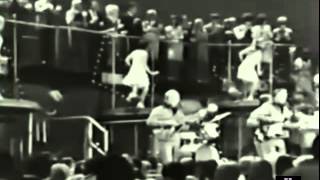In an alternate reality where the British Invasion never occurred, and American music evolved independently in the 1960s, one can only speculate on what it would have sounded like.
The enigmatic figure of Bobby Fuller, known as the “Rock’n’Roll King of the Southwest,” emerges as a key player in this imagined scenario.
His life was cut short at the young age of 23 on July 18, 1966, under mysterious circumstances.
Fuller, a multi-talented individual who dabbled in songwriting, performing, producing, and more, crafted a distinctive sound that fused southern influences with the raw, heartfelt rock’n’roll vibes of artists like Buddy Holly and Ritchie Valens.
Contrary to the prevailing notion that American music needed a boost from across the pond, Miriam Linna argues that Bobby Fuller was already shaping the American pop music landscape before the British Invasion.
In her book “I Fought the Law: the Life and Strange Death of Bobby Fuller,” co-written with Randy Fuller, Bobby’s younger brother and bandmate, a case is made for reevaluating Bobby Fuller’s significance in American music history.
Randy recalls Bobby’s conviction that the Beatles could never replicate the essence of Buddy Holly because they lacked the inherent Texan rhythm and cadence ingrained in regional music genres like blues, R&B, western swing, and Tejano.
“I Fought the Law,” a chart-topping hit for the Bobby Fuller Four in March 1966, became an emblematic anthem of outlaw rock’n’roll.
The song’s high-octane energy propelled it to fame, overshadowing Fuller’s talent as a songwriter and arranger of poignant tracks such as “Let Her Dance” and “Never to Be Forgotten.”
Bob Dylan even reimagined Fuller’s ballad “A New Shade of Blue” on his own album, underscoring Fuller’s profound impact on his peers.
Before achieving national recognition, Fuller was a local hero in El Paso, where he built his own recording studio at a tender age and established his labels to release his music.
Inspired by the surf music scene in California, Fuller opened a teen club in El Paso, where his band, initially known as the Fanatics, stirred up excitement among local youth.
Their relocation to California in 1964 marked a turning point, leading to a deal with Del-Fi Records and a meteoric rise to teen idol status after the success of “I Fought the Law.”
However, the promising trajectory of the Bobby Fuller Four was marred by conflicts with their manager, Bob Keane, and ill-fated marketing gimmicks that veered them off course.
Fuller’s untimely demise on July 18, 1966, further clouded his legacy, with initial reports suggesting suicide.
The circumstances surrounding his death remain shrouded in mystery, fueling various speculations ranging from drug-related accidents to sinister conspiracies involving influential figures in the music industry.
Despite the uncertainties surrounding his death, those close to Fuller believe he had the potential to revolutionize the music scene had he survived.
Randy Fuller envisions a scenario where Bobby returns to El Paso, embarks on new creative ventures, and cements his status as a visionary akin to icons like Brian Wilson and Phil Spector.
Linna echoes this sentiment, suggesting that Bobby Fuller could have spearheaded a musical evolution that transcended borders and reshaped the global music landscape.
The legacy of Bobby Fuller and the Bobby Fuller Four remains a poignant reminder of a promising talent extinguished too soon, leaving behind a trail of unfulfilled potential and unanswered questions.



